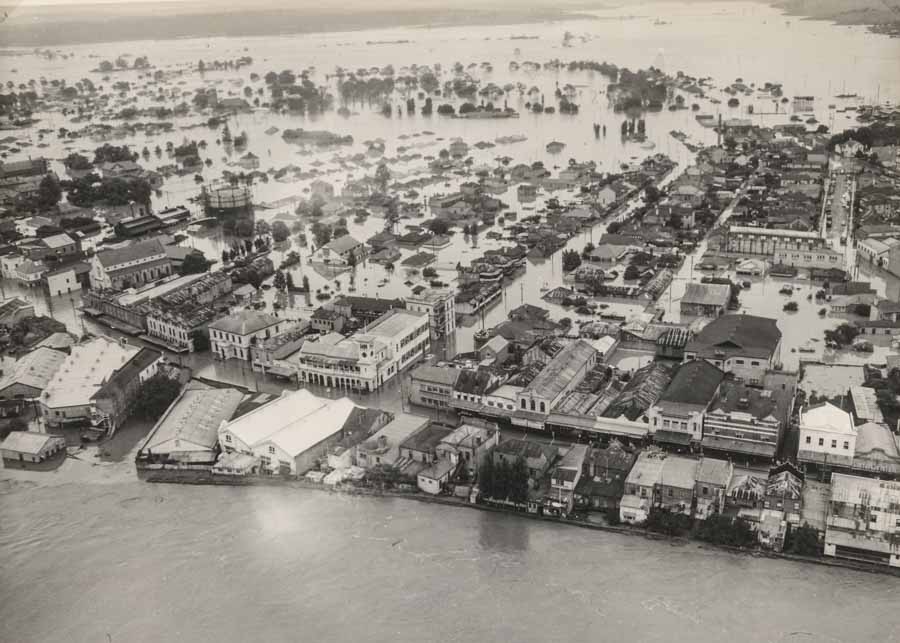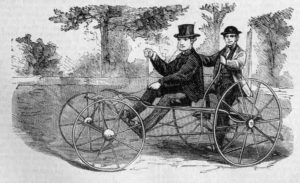This is part two of an account of the 1955 flood, as it affected the Hunter Region, particularly Maitland. For Part 1, see link below.
********************************************************************************************************************
The chaos of Friday and the terrifying night that followed gave way to a slightly more organised situation on Saturday as rescue operations moved into high gear and more volunteers descended on the drowned city of Maitland. But the confusion was still immense and nobody had any real idea of the death toll, which was assumed to be at least 20. People were frantically trying to contact missing family members.
In High Street, some areas were now free of water, but a thick layer of slime remained. Most shops were still deep under water, which was still flowing quickly in many areas. Refugees were jammed into various receiving stations – official and unofficial – where they huddled grimly with their few possessions, waiting for the authorities to devise a workable evacuation plan.

Terrible rumours of new “walls of water” on the way from the Upper Hunter plagued the people, and even surfboat crews were distracted from their work by overplayed tales of massive damage in Newcastle, and especially Stockton.
Thousands made homeless
Overnight the flood made thousands of people homeless and the overwhelming priority for authorities was to find shelter and food. Greta migrant camp had been prepared and from Sunday the 27th a relay of amphibious army DUKWs and regular trucks and buses began shifting people in their hundreds to their temporary new homes. At the same time the sick and injured were ferried to Maitland Hospital which was struggling under a massive workload of flood-related injuries.
Extra impetus was given to the evacuation by fears among some medical experts that an epidemic could break out in the far-from-hygienic ruins where gas, water, sewerage and electricity services were a shambles.

The high school was already showing the strain of accommodating so many people and one DUKW crew, trying to put some humour into a grim situation, labelled their craft “B.O. Plenty” – a reference to a character in the popular American cartoon strip, Lil Abner, and a comment on the atmosphere in cramped vehicles packed with unwashed flood refugees and rescue workers. From early Sunday the DUKWs carried refugees on the 15-minute ride over half a mile of rough water from the Girls High School in Church St to high ground at West Maitland. From there the evacuees took another 20-minute bus ride to Greta. By noon the first 500 had arrived at their temporary new home.

Hundreds of refugees were welcomed into private homes all over the Hunter, with large numbers heading to Newcastle where special reception centres were hurriedly set up by a volunteer citizens’ committee that handed out food and clothes and arranged transport and shelter. About 80 families from Maitland were accommodated in caravans at Waratah. Another 30 were relocated into Nissen huts in Main Road Rutherford. Caring for these refugees was a vast exercise that called on the combined resources of the military, government agencies at all levels and the traditional charity groups that took over feeding and clothing during the worst of the crisis.
Armada of aircraft
During the first few days, when the velocity of the waters had eased but their levels had yet to subside, isolated pockets of people were scatted across big areas: on farms, haystacks, rooftops, hills, elevated patches of roadway, bridges and on awnings of buildings in the main street.

An armada of aircraft criss-crossed the cloudy skies, hunting for survivors and, where possible, dropping vital supplies in specially designed “store-pedoes”. Royal Newcastle Aero Club members flew huge numbers of flights, supplementing the massive effort of the RAAF which threw everything it had – from spotter planes to Lincoln bombers – into the task. In six days planes from Williamtown flew 180 sorties and at its peak the aerial supply drop totalled 1000 parcels a day in the Maitland area and three times that number in Singleton, Muswellbrook and Denman.
Ham radio operators won special praise from the emergency services too. Where official communication networks failed, the amateurs stepped into the gap and made sure SOS reports from stranded people got through to rescue coordination centres.
The emergency brought out the best in the Hunter community. Private businesses abandoned thoughts of profit and channelled their productive efforts into flood relief. Bakeries cooked hundreds of gratis loaves, refrigeration mechanics donated their labour to fix ruined fridges, tradesmen of all kinds chipped in to help those whose homes and livelihoods had been wrecked.

Scarcely had word of the disaster hit the headlines than huge sums of money began pouring into relief funds all over Australia. International charities didn’t stint either, with big pledges coming from overseas. Lake Macquarie artist Sir William Dobell donated a landscape painting to be raffled for the flood appeal. American singer Johnny Ray, touring Australia at the time, donated the first thousand pounds from his concert to the cause. Naturally this was not all earmarked for the Hunter: huge tracts of NSW were almost equally affected. With such largesse, the usual bickering between the State and Commonwealth over who should pay what to whom became a relatively minor and somewhat embarrassing irritation.
Newcastle affected
As the flood moved down the Hunter River, many parts of Newcastle were seriously affected. On March 1, The Newcastle Sun reported that scores of volunteer workers had helped evacuate nine families from Sandgate, 42 from Birmingham Gardens and four from Boscawen and Charles Sts, Wallsend. Nelson St, Wallsend was covered in shallow backwash from Ironbark Creek, and Federal Park was nearly two metres under water. That didn’t stop the staff of the Wallsend Co-operative Bakery from working in water up to their knees on Saturday night to cook 600 loaves of bread to give to flood victims.

The flood reached its peak in Newcastle on Saturday, February 26, and during that night several families were evacuated from Cameron St, Jesmond. A high tide at roughly the peak of the flood caused water to back up into the heavy industries and some residential streets at Mayfield West. BHP, Lysaghts, Rylands, Newcastle Chemical Works and Joseph Sankey and Son were all affected and some lost production.

The harbour, still recovering from a heavy deposition of silt in the 1949 flood, suffered an even bigger dose, forcing the State Government to accelerate dredging. In the days before Stockton Bridge, a car ferry connected Newcastle with the road north. The flood silted the harbour so badly that the ferry was prevented from running too close to low tide.

Stockton lost its water supply for some days when its pipeline under the harbour was damaged by floodwaters. Raymond Terrace was very hard-hit, with most of the town’s shops under water at the flood’s peak. The new Windeyers Creek bridge was more than 2m under. Hexham suffered record flooding, with not a house spared. Four riverside houses were swept away and the Dairy Co-op factory was covered by four metres of water. Almost the whole population of the suburb was evacuated to St Josephs home at Sandgate. An air force boat had to rescue 60 people from Hexham Bridge, battling the current for two-and-a-half hours to make the trip from Newcastle Harbour. The former rich farmlands of Ash Island were ruined, with entire herds of cattle destroyed.

The immense amount of water in the Hunter Valley took a long time to be funnelled out through the mouth of the river at Newcastle. For five-and-a-half days the flood levels at Maitland remained above the critical 9m mark. As they gradually subsided they revealed many heartbreaking sights.
When NSW Premier Cahill finally deigned to visit the city on March 4 for a quick tour by army DUKW, (he detoured to inspect some roadworks in Sydney on his way north) a large section of South Maitland and Horseshoe Bend was still under metres of water. With both State and Commonwealth governments arguing about who should pay how much and for what, it was hardly surprising that Mr Cahill was advised by some mud-spattered workers to “get a shovel”.
Houses had disappeared
In Mount Pleasant Street many houses had simply disappeared, leaving scattered steps, piers and bricks. Two had been shifted bodily to the middle of the street where their owners did their best to clean them up. Everywhere were piles of ruined furniture: mattresses, lounges, rugs and other items all beyond repair and awaiting disposal. In Hannan St, homeowners had to cut tunnels through piles of silt and rotting weed to reach their front doors.

Farms were hard hit too. Huge numbers of stock had been drowned and washed away, along with fences, haystacks and farm buildings. Entire crops were lost and, what made things worse, tonnes of sand were deposited in thick, stinking layers over hectares of what had been prime farmland.
Above all in most people’s memories was the smell. Unbelievably disgusting, it was a cloying mixture of moisture and decay that assaulted the nostrils and was completely inescapable. Men worked in the streets with sanitary napkins tied over their mouths and noses to avoid the worst of it, but that was a token gesture: there was no escaping the stink.
Mammoth rebuilding task
As the filthy water gradually receded people began to tally the damage. Across the Hunter 58 homes were washed away, 31 of them in Maitland. Another 103 were so badly damaged they had to be demolished. In all, 5200 homes were invaded by water that ranged in depth from a few centimetres to several metres In Maitland 2180 were affected, while the number in Singleton was 1250 and in Muswellbrook 370.
It was obvious, once the early phase of evacuation and emergency response was over, the worst affected areas faced a mammoth rebuilding task. Where the western end of the battered Long Bridge had once been was a “chasm” more than 2m deep and 300m wide.

All over the Hunter, thousands of people, shocked by the extent of the disaster, volunteered to help those affected. In Newcastle many queued for hours at City Hall and the police station to get permits to go and help. Workers at Newcastle’s heavy industries were especially keen to help their Maitland-based workmates and Lysaghts alone sent 18 truckloads of men and equipment on March 6. BHP provided trucks and gear to the large number of its workers who volunteered to help, as did Stewarts and Lloyds, Rylands and the State Dockyard. Many other smaller firms, as well as clubs and trade union organizations also did their part.
Thousands rallied to help
Thousands of miners and waterfront workers rallied to help and the indefatigable surf clubs, having done so much already, next threw themselves into unloading tons of donated stock feed sent to try to save surviving cattle and other animals on ravaged farms.

Naturally there were sightseers too, and these were a positive nuisance, clogging roads and hindering cleanup workers wherever they appeared. Worst of all, some people could not resist the temptation to loot and pilfer unattended flood-damaged homes and businesses. Maitland residents formed vigilante committees, men stayed in their damaged homes with weapons close to hand. Some families were dismayed when they went to reclaim furniture previously stored in safe buildings on high ground, to discover that thieves had taken the lot. Whenever looters were caught the police and courts showed them no mercy and their names were paraded in the newspapers for all their acquaintances to see.
In the Hunter Region many people even today refer to the floods of 1955 as “The Maitland Floods”. That title properly recognises the huge impact of the floods on Maitland, but it creates an impression in some minds that the disaster was in some way localised. Nothing could be further from the truth.
Statewide dislocation
Even while Maitland was beginning to recover from the hammer blow it was dealt in late February, 1955, other parts of the state were still facing major flooding problems. On the other side of Great Dividing Range many of the western rivers burst their banks and joined to form a vast inland sea. Other areas hit hard were Tamworth, Nyngan, Dubbo, Gilgandra, Trangie, Warren, Brewarrina, Narrabri, Moree and Narromine.
The dislocation caused by the floods, right across NSW, was enormous. Rail and road links were thrown into unprecedented disarray. Mail deliveries were delayed. Coal couldn’t be transported to the cities where it was needed to make gas for cooking and lighting, and mines were forced into idleness, leaving miners without work. Power lines and substations were damaged in a myriad places, as were telephone connections and water pipelines. Households, even in unaffected centres, were unable to obtain their usual supplies of vegetables, fruit, meat and milk. In a time when freezers were rare in shops and non-existent in private homes, maintaining fresh food supplies was critical.

To deal with this immense crisis more than 1000 police, about a quarter of the State’s force, were mobilized. The Army – both regulars and reserves – played a huge part, with an estimated 2000 soldiers, 30 DUKWs and hundreds of trucks and other vehicles used. In the air, the RAAF deployed 50 aircraft, including Dakotas, Lincolns, Ansons, Fireflies, Vampires and a helicopter flown from Woomera. The air force contributed more than 1000 personnel in a range of capacities both in the air and on the ground. The Navy contributed six helicopters, one of which was lost at Maitland.
Officially the death toll from the 1955 floods in the Hunter Region was 14 lives: 11 in the Maitland area and three near Singleton, with nine drowned and five electrocuted.
********************************************************************************************************************
More links
********************************************************************************************************************



